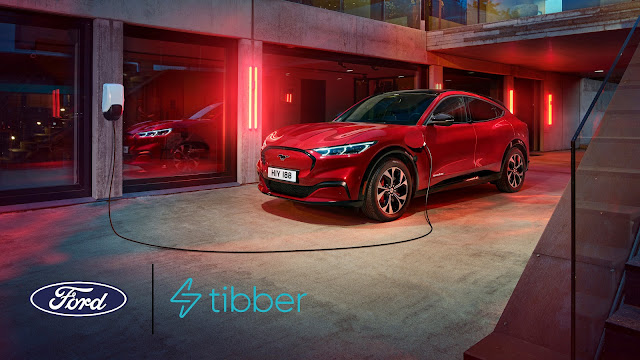Smart charging to save you money
Our commitment to electric vehicles is underpinned by offering our customers the best ownership experience as well as looking after the planet.
That’s why we have begun partnerships with energy providers Tibber in Germany, the Netherlands and Norway, and Octopus Energy in the UK, to make charging easier and help reduce costs for owners.
Starting with our Mustang Mach-E 1,2 from early next year and the new Ford Explorer 3 when it arrives later in 2024, a new Dynamic Charging feature allows compatible vehicles to communicate with the energy providers’ intelligent supply networks.
Drivers will simply plug in their car, use the smartphone app to enter the desired state-of-charge and departure time, and the battery will be charged using tariffs to minimise cost and optimise renewable energy use. 4
Our research shows that up to 87 per cent of Mustang Mach-E drivers charge at home and that the cost of energy used is the most important consideration when charging. And according to Tibber, more than one million users have already used the company’s platform to change their energy behaviour.
Depending on the market, these new energy services can offer benefits when charging day or night. The connected technology can automatically optimise charging to use cheaper off-peak electricity at night, and lower energy prices that come from peak supply of renewable energy like solar during the day.
We’ll offer ten electric vehicles in Europe by 2025, including Explorer, Mustang Mach-E,
F-150 Lightning, 3 Puma, 3 E-Transit, 5 E-Transit Custom, 6 E-Transit Courier, 3 E-Tourneo Custom, 7 E-Tourneo Courier 3 and a mid-size crossover, and we’re planning to roll out these energy services to more electric products through 2024 and beyond.
Martin Sander, general manager, Ford Model e, Europe
“With every electric car that takes the road, we’re getting closer to zero emissions transport – but to reach the finish line, we need to make green driving cheap and accessible. Our smart tariffs allow drivers to tap into cheap renewable power, potentially saving drivers hundreds of pounds a year while doing their bit for the planet.”
Michael Cottrell, partnerships director at Octopus Energy
“As the pioneers of smart charging in Norway and Germany, we are excited about this new partnership with Ford. We are impressed with Ford’s ambitions and have a shared mission to empower consumers to use energy more smartly. To do so, consumers need the best tools available to take control of their energy consumption effectively, and our collaboration will offer consumers a seamless charging experience to the benefit of their wallet and the planet. We look forward to welcoming Ford customers to the Tibber universe.”
Børge Dvergsdal, manager, Smart Charging, Tibber
1 In accordance with the Worldwide Harmonized Light Vehicles Test Procedure (WLTP). A range of up to 600 km (intended target value according to WLTP) can be achieved with a fully charged battery - depending on the existing series and battery configuration.
2 The actual range may vary due to various factors (e.g. weather conditions, driving style, route profile, vehicle condition, age and condition of the lithium-ion battery).
3 Officially homologated driving range will be published closer to on-sale date.
4 Octopus Energy blog - Where does our 100% green electricity come from?
5 In accordance with the Worldwide Harmonized Light Vehicles Test Procedure (WLTP). A range of up to 317 km (intended target value according to WLTP) can be achieved with a fully charged battery - depending on the existing series and battery configuration.
6 In accordance with the Worldwide Harmonized Light Vehicles Test Procedure (WLTP). A range of up to 337 km can be achieved with a fully charged battery - depending on the existing series and battery configuration.
7 In accordance with the Worldwide Harmonized Light Vehicles Test Procedure (WLTP). A range of up to 325 km can be achieved with a fully charged battery - depending on the existing series and battery configuration.

Comments
Post a Comment
Dear Commenter: please note that comments appear after moderation. Do not submit spam. Thanks! 👍